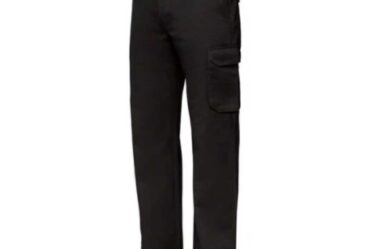
Stacy Flynn has spent a decade waiting for the fashion industry to commit to recycling old clothes. This week, she got tired of waiting.
On Tuesday Evrnu, the US-based textile recycling company she co-founded in 2014, launched its first own-brand product, a $600 waffle knit hoodie designed by menswear designer Christopher Bevans.
The steep price point reflects the fact that Evrnu has yet to scale production of Nucycl, the regenerated fibre it produces from discarded cotton textiles. Though the company has raised $31 million and secured $500 million more in purchase commitments, it needs more cash to complete construction of its first commercial facility. And for that, it needs to show there is a market for what it’s making.
“Let the consumer decide; let the consumer vote,” said Flynn. “My fear, and probably the fear of many early stage companies, is that we run out of runway before people wake up.”
That, in part, is what happened to Swedish recycler Renewcell, a much-hyped innovator that filed for bankruptcy last month. The company was among the first to offer the industry access to new recycling technology at scale, but sales didn’t materialise fast enough to sustain the business.
It’s the latest in a slew of high-profile failures that have raised the stakes for innovators like Flynn, still trying to forge ahead against tumultuous market backdrop. But while the situation has served as a cautionary tale, it’s also been a wake up call for brands and investors that had been cautiously sitting on the sidelines, according to industry insiders.
In its wake, new money and new commitments have hit the market. H&M Group, one of Renewcell’s biggest backers, has teamed up with green industry investor Vargas and private equity group TPG in a $60 million bet on polyester recycling venture Syre. Finnish recycler Infinited Fiber managed to close a €40 million ($43.7 million) funding round last week with support from Zara-owner Inditex and TTY Management, an asset management company owned by Fast Retailing CEO Tadashi Yanai. Gap Inc.’s Athleta brand said it plans to start using recycled polyester supplied by LA-based start-up Ambercycle from 2026.
The investments are a bet that incoming regulations and high-profile climate commitments will spur a surge in demand for recycled materials in the coming years. What remains to be seen is whether the industry can shift fast enough to meet it.
“It’s taken time for the brands to start to mobilise, but that battleship is starting to be turned,” said Luke Henning, chief business officer at recycling start-up Circ. “The severity of the crisis has helped galvanise some of the players.”
First Mover Disadvantage
Renewcell’s failure has shaken the industry because the company had proven its viability beyond a hyped up concept. While many buzzy start-ups have promised to transform fashion with eco-friendly alternatives to materials like polyester, cotton and leather, the Swedish company was one of the first to actually reach commercial scale.
Its factory in the coastal Swedish city of Sundsvall was steadily ramping up production and, with a network of suppliers and brands ready to use the company’s product, it seemed poised for success.
Instead, the company launched a largely untested, premium-priced raw material into a brutal downmarket and quickly ran into a host of structural challenges. It struggled to efficiently navigate the complex maze of suppliers needed to connect the big brands it targeted as end customers to the raw material it produced. Adding new partners made it harder to control costs and quality levels, hiccups that required time and money to resolve.
“It’s a mismatch between a very good technical facility and capacity and where the market is,” said Renewcell’s bankruptcy administrator, Lars-Henrik Andersson. “The market unfortunately is not ready yet.”
The rest of the industry is scrambling to learn from these mistakes.
Innovators said they are putting more focus on developing their materials and purchasing agreements with small groups of strategic suppliers to ensure their products have a route to market, as well as strong quality assurance at the point they hit scale.
“We’ve done more work than I would ever have imagined with suppliers,” said Ambercycle CEO Shay Sethi. The LA-based polyester recycler has a €70 million purchasing commitment from Inditex as well as plans to work with Athleta. It’s aiming to have its first commercial plant operational by 2026.
Brands are also facing pressure to make firmer purchasing commitments, increasingly a prerequisite to unlock the cash needed to get new materials to scale.
“Disruptive times are calling for creative measures,” said Nicole Rycroft, founder of environmental non-profit Canopy, which works with brands to support the introduction of new materials. “We’re seeing brands making commitments that would have been highly unusual two years ago.”
Syre, the newly launched venture backed by H&M, Vargas and TPG, has been underwritten by a $600 million take-or-pay purchase commitment from H&M. The company, which is aiming to have its first production facility up and running by the end of the year, also isn’t planning to rely solely on the fashion market, with ambitions to diversify its reach to car makers and home furnishings.
Things aren’t over for Renewcell, either. Dozens of parties have shown interest in buying the company’s assets out of administration, according to Andersson. A deadline to place indicative bids for the company has been extended from this Friday to March 28.
Building the Market
Ultimately, the success of these recycling ventures rests on companies delivering on high-profile sustainability commitments. Based on their promises, many of the world’s biggest fashion brands will need to convert swathes of their sourcing to materials with a lower environmental impact. And increasingly those aren’t just voluntary marketing messages. Incoming regulations led by the European Union are set to establish new requirements for more climate-friendly product design, including mandates for recycled content.
“In the next 10 years, there will be quite a big supply gap in recycled materials,” said Dennis Nobelius, CEO at newly launched recycler Syre.
What remains unclear is how much brands will pay to bridge it. New materials come with a green premium that so far the market has had little appetite to digest.
Long-established mechanical recycling processes, which shred old textiles into fibres that can then be woven back into fabrics, are already able to compete with conventional materials on price. Where they’ve lagged in the past is on quality. The shredding process shortens the fibre length, making it weaker and more prone to fray. But suppliers say they can overcome these issues by blending recycled and virgin materials and using modern spinning techniques.
“We’re seeing aggressive demand,” said Faisal Ahmed, CEO at Pakistan-based manufacturer Artistic Denim Mills. The company has partnered with Goldman Sach-backed recycler Recover and counts companies including Levi’s, Zara and H&M among its customers.
Newer technologies may be able to compete on price in time, but not without scale and proof in the market. Conversations are underway behind the scenes to try and reduce costs where possible, for instance by agreeing standardised fabric blends with multiple customers when a new material first launches, but there’s no silver bullet.
Adding to the complexity, the infrastructure to collect and sort old clothes for recycling is nearly non-existent. Most recyclers require material that fits a certain spec in terms of cotton or polyester content, but sorting is still largely manual, time consuming and costly.
For recycling innovators to succeed this infrastructure and consumer demand need to scale in tandem with their technology.
“You cannot push play unless you have this whole thing worked out,” said Patrik Frisk, the former CEO of Under Armour who now runs Reju, a polyester recycling venture backed by engineering and technology company Technip Energies. “It may take a little longer than everybody wants.”



